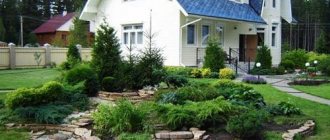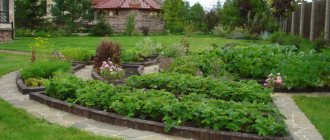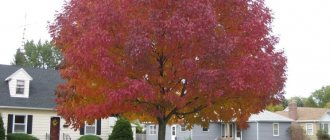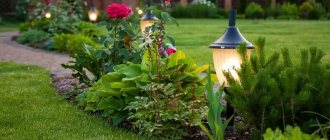Many of the gardens and parks of this country were created several centuries and even a thousand years ago, and are still admired today. Perhaps the first association that comes to mind when talking about England is lawn, garden, landscape.
This country is famous throughout the world for its traditions and has been dictating the rules for creating picturesque landscapes for centuries. For every Englishman, a garden and a park are an essential part of his home, his life.
English gardening traditions are centuries old, perhaps even millennia old. They say that the landscape style of landscape design began to emerge in England back in the 8th century: gardens at monasteries began to be arranged according to certain rules. But let's take a walk together through a typical English park and look at its basic rules.
Daffodils bloom in English parks as early as February
Main principle: follow the spirit of the place
This country is inimitable in its fidelity to traditions, including gardening ones. Almost all the parks here have retained the layout that was conceived when they were created several hundred years ago.
The dominant points of the landscape of every old estate or castle are necessarily trees, whose age is amazing: the oldest yew in Great Britain is approximately 5 thousand years old! He grows up in Scotland, the English call him Fortingale.
Here, in general, history is very close. Any resident of Albion will tell you that the turf of the Tower lawn on which the head of Anne Boleyn, executed by Henry VIII, rolled 500 years ago is still the same!
The classic rules of English garden design have remained unchanged over the last millennium. Their main principle is to follow the spirit of the place.
The main impression that an English park should leave is absolute naturalness.
When organizing a garden or landscape park, there is no need to try to change nature. It is only necessary to correctly place emphasis on what has already been created. That is why in the English park there are almost no straight lines, characteristic of regular gardens in Europe. There cannot be asphalt paths here, only gravel paths made from natural materials. And each of them does not cut through the perspective, as in the regular gardens of Europe, but flows, repeating the lines of the landscape.
Here the concepts of garden and park are often mixed. A garden in England is not only about fruit plants. Everything that is not a large city or castle park is called a garden, although in our minds it bears little resemblance to it.
The basic rule of the English gardening style is that everything should look as if it is growing without human intervention. But behind this picturesqueness and apparent naturalness lies the enormous work of several generations of gardeners. Needless to say, this profession is very respected here and is passed on from generation to generation in many families. And a gardener of non-English origin will have great difficulties finding employment here.
Concept and principles
In its philosophy and aesthetics, the English garden is closer not to wild nature, but to pastoral painting. The gardener’s task is to recreate a luxurious idyllic landscape worthy of classic paintings or collectible postcards. Despite their apparent simplicity, English parks are thought out to the smallest detail, including combinations of shades and halftones, transitions and contrasts.
Important: the English garden was the backdrop for traditional country estates of the 18th and 19th centuries.
Landscape garden surrounding an ancient estate in England
The atmosphere in them is conducive to long leisurely walks, pleasant conversation, reflection and contemplation of nature. The English garden gives the impression of aristocracy, slightly beyond the bounds, but without losing its nobility and sophistication. Although he loves space, it is quite possible to arrange it on the usual six hundred square meters. It is important to adhere to a number of principles:
- Plant abundance (use many different flowers, herbs, trees),
- Unity with nature (predominance of curved lines and natural outlines, decor and finishing made from natural materials),
- Spaciousness (lawns and lawns occupy about 40% of the area),
- Flow (soft smooth boundaries, one flows into another)
- Contrast (combinations of shades, volumes, textures),
- Antiques (vintage furniture, aged surfaces, antique-style decor).
Important: when decorating a garden, prefer natural materials such as wood, stone, ceramics, glass, etc.
Lawns and lawns are essential elements of an English garden.
Consistency in everything
The English love of gardening became constant around the 17th century. At that time, Huguenots from Holland moved to the island en masse, and it was they who instilled in the inhabitants of Albion a passion for floriculture. And picturesque flower beds with roses appeared in English parks, which have now become one of the symbols of the country.
This park at Leeds Castle has not changed its outline for centuries.
Consistency in garden design is strongly influenced by the temperate English climate, in which plants feel very comfortable: they do not freeze in winter (after all, there is no frost here) and do not dry out in summer (average summer temperature is +16 ° C), and it often rains. Therefore, there are many evergreen plants here - from ficus to yucca. And the forests look green even without leaves - many of them are covered with evergreen ivy.
An English garden is always built “from the landscape”: it emphasizes the most beautiful natural places and decorates the less picturesque ones with the help of vegetation.
Natural materials
By the way, about paving and coatings . Usually they are gravel, brick, wood or lawn, and in no case should they look like a remake like lifeless flagstone with completely worn out seams. Old brick is an ideal material for garden paths (and if you lay it edgewise, then for borders) or low retaining walls. Used railway sleepers can also be used as curbs, elements of paths or steps.
Country in English
Cottage garden is a characteristic style for a small English house. Such pastoral pictures of houses surrounded by flowers are very popular on the Internet, you've probably seen them.
Residents of provincial England liked the pastoral cottage garden
All the plants here always sit very tightly. By winning each other's living space, they only become prettier. This style is characterized by staggered plantings - flowers here are usually in close proximity to useful plants: violets perfectly set off spinach or low-growing varieties of tomatoes. And without fail there are a lot of spicy and aromatic herbs that grow not only in flower beds, but also in numerous pots displayed in the courtyard. Probably, our country houses are vaguely reminiscent of the Cottage garden style. But they don’t have the same charm of being lost in the vegetation. However, this is impossible with our small footage.
Historical styles of gardens in England
- Neoclassical (Augustian style) 1730 Classical landscape with water, grass, forest and classical architecture.
- Winding landscape (Serpentine style) 1750. There were curved lines throughout, and a lawn appeared near the house. This style is also called Brownian, in honor of its creator Lancelot Brown.
- Picturesque style 1790. Picturesque parks with completely new, exotic plants, such as rhododendrons and camellias.
- Landscape style (landscape) 1794. The closest to natural nature with a foreground, the main part of the garden and a background.
- Electrical (mixed style) 1810 Elements from other countries' gardens began to be added to the gardens.
- Garden style of 1829. Plants atypical for the area became at the peak of popularity, and the fashion for round-shaped flower beds and flower beds spread.
- Applied arts style (artistic) 1890 Clear boundaries appeared between the fenced area with geometric flower beds near the home and the wild garden. The choice of plants, building materials, presentation of shapes and colors began to be treated with special sensitivity; everything had to be the best and fit perfectly.
Of the later ones, it is worth noting the abstract style and postmodernism.
Vertical gardening is a must
Landscaping in any English park - be it a small cottage garden or a large park - is not only horizontal. Every English garden should have arches, pergolas, gazebos, and in large ones - the ruins of rotundas and fragments of ancient stonework - they are very picturesque, and also serve as an excellent support for climbing plants.
Any architectural structures in a landscape park are always secondary
Small architectural forms of an English garden should be aged, covered in places with moss, as if nature is trying to return what man has taken away. This is called “fitting into the landscape.” Architectural structures in a landscape park are secondary - an arch or pergola should be absorbed by a plant that masks all the sharp corners, smoothes it out and reconciles it with the natural landscape.
Old things
Old things are a symbol of a cottage garden . Nothing conveys the atmosphere of nostalgia for the old days better than rusty garden tools hanging on the wall, clay pots with salt deposits placed on the steps of an old wooden staircase, or wicker wooden baskets with flowers. You can look for similar items at flea markets. Left: nothing conveys the atmosphere of nostalgia for the old days like old things. Right: paving and coverings should never look like a remake
Looking for the climax
When entering an English garden, a person should not be overwhelmed by everything at once. It is expected that he will gradually discover the park for himself, contemplating new landscapes and views at every step of the way. In the parks of famous English estates, the change in perspectives seems to have been orchestrated by a skillful designer: first we admire the view of an ancient yew tree, and at the next bend of the path we see a small thatched barn (such structures here are considered a landscape decoration). Subject to these compositional rules, the palace, castle or main house of the estate looks as if it was “fitted” into the existing landscape, rather than laid out as a park around it.
The culmination of an English garden or park most often becomes a picturesque pond
And the culmination of an old English park is almost always an abandoned pond, a small lake, a stream or a backwater on which waterfowl nest. They are very popular here. Many large parks are proud of the number of their feathered inhabitants, many of them have a curator who monitors their diet and health.
Common features
The appearance of a traditional English-style garden continues to be an example of landscape art for many. The described direction was formed to create an alternative to the regular French park. At the end of the eighteenth century, many were already tired of the geometrically correct layout, which had pronounced symmetry with straight alleys, parterres and ponds. It was impossible to be too distracted from the theme of classicism at that time; his ideal paintings were in fashion. But society was tired of the effect of man’s absolute control over nature, so the idea of creating a park appeared, which outwardly looked like a man-made natural extension of the surrounding landscape.
The beauty of nature within the framework of man-made processing Source standard.co.uk
The creators of such creations sought a balance between interference with natural nature and its unbridled temperament. Therefore, the new trend was based on the principle of the element of unpredictability. Walking through such a park, a person did not know what awaited him around the bend of the alley. To realize such aspirations, a variety of picturesque elements were used (small bridges, pavilions, fountains, flowerpots, pyramids, decorative structures stylized as ruins).
Gardens in the style described have an amazing sense of proportion; they look noble and picturesque. Their aesthetics are highly functional. The principles of its construction are considered unshakable. They can be used by anyone who dreams of creating a small green corner in the style of old England in their dacha. To do this, you must adhere to the following rules.
Lush noble beauty Source pinterest.com
Basic structure
An English garden in landscape design is an object with a clearly planned structure. Its basis is walking areas, the routes of which allow you to observe the change of decorative objects. Their selection is strictly limited. The generally accepted ones are:
- large green lawn ;
- front garden;
- open light gazebo in the form of a pavilion;
- a garden created from fruit or ornamental trees;
- picturesque pond .
All these zones are separated from each other by walls made of stone, reminiscent of ancient ruins, or by impeccably trimmed green fences. When placing the listed objects, it is necessary to adhere to strictly defined boundaries.
Stone walls in a classic garden Source yandex.ru
The space between the decorative inserts is united by routes intended for walking. They are formed using paved paths or soft paths sprinkled with gravel. Along them you can plant flower beds and make ridges. You can complicate the task and place them inside green boxwood labyrinths. The business card of landscape design in the style of an English park is one-sided or two-sided mixborders.
Basic principles of the English landscape garden:
- layout, the conditions in which can only be dictated by the landscape;
- everything that is beautiful in a given area must be emphasized;
- the garden should open gradually, views from different angles should not resemble a mirror image;
- small architectural forms should be densely decorated with vegetation;
- The visitor should be left with a feeling of naturalness and serene charm.
A classic English house should be surrounded by flowers
A few words cannot describe everything that has been cultivated in England for thousands of years. The oldest parks here were laid out more than a thousand years ago and still look impeccable. This country remains a trendsetter in gardening for the whole world; it is here that the largest and most authoritative exhibitions of garden and floral design are held; most landscape design gurus around the world have an English education. But this is not even the most important thing. Traveling through this country left me with a clear conviction: the British cannot imagine themselves without a kindergarten. Even if it can fit on a windowsill or balcony. But he must be. And it contains the freshest new items of the season.
Read about what the gardens of ordinary English residents and the gardens of palace estates look like in the second part of our story.
Landscape layout
The landscape layout of the cottage garden meets the demand for emphasized naturalness. Undoubtedly, it may contain geometric modules: platforms and terraces, straight paths, whists, flower beds and beds, ponds. It can even be divided into rectangular "green rooms". However, thanks to the informal plant design, the garden will still be perceived as a series of landscapes . Despite the presence of geometric modules, the container garden is still perceived as a series of landscapes. It also has a sundial!
And the hands are green
A bad gardener is one who buys seeds at the market. After all, it is much more interesting to select the seeds of the best plants for planting next year. For example, in the county of North Yorkshire, the most anticipated event in late autumn is the Harvest Festival, at which townspeople not only compete in growing the largest vegetable, but also hold an auction where they sell seeds and seedlings of their own production.
For good gardeners, there is even an expression - “have a green hand”, which literally translates as “to have a green hand”, which metaphorically describes a hard worker who loves to garden, in whose hands everything begins to grow and bear fruit. We can say that many British people have “green hands” up to their elbows, because caring for a vegetable garden is fun not only for the older generation.
It is easy to change the appearance of the entrance group by combining different containers. Photo: Shutterstock.com
Garden flowers, shrubs and trees
To create the effect of a relaxed English-style landscape, you need to plant plants in layers. That is, the tallest ones should be at the back, the lower ones should occupy a place in the middle, and the smallest ones should be placed on the edge. Stick to the color scheme. Choose primary colors either only in cold shades (blue, purple, white, cold pink) or warm shades (red, orange, yellow). This way you will create a unified concept for the garden.
David Austin Roses
The British prefer romantic, old-fashioned flowers. If you live in a dry climate, provide them with enough water. It is impossible to imagine the gardens of England without such plants as: roses (especially popular are the varieties of the English breeder David Austin), mallow (Malva sylvestris), daylily (Hemerocallis), delphinium (Delphinium consolida), peonies (Paeonia), charming cosmos flower (Cosmos), foxglove (Digitalis), snapdragon (Antirrhinum).
Lavender (Lavandula), catnip (Nepeta cataria) and hosta (Hosta) will occupy the middle level. Thanks to the soft shades, they create an ideal contrast with the richness of annual and perennial flowers.
An English park is also full of trees. Suitable hedges include yew (Taxus), hornbeam (Carpinus), oriental thuja (Platycladus orientalis), boxwood (Buxus), and magnolia (Magnolia). They tolerate cutting and shaping well and are suitable for creating topiary figures. Evergreen spruce trees (Picea abies, Picea orientalis), junipers (Juniperus communis, Juniperus virginiana), and pine trees (Pinus sylvestris) will hide the fence.
Plant supports
Plant supports are another opportunity to show your imagination.
Supports for plants are another opportunity to show your imagination. What can you see in English cottage gardens in this incarnation: metal gates, shaped iron headboards of beds, and bicycle wheels mounted horizontally on a leg, through the spokes of which crumbling bushes grow. Naturally, everything is old, rusty and pretty . And “wigwams” for sweet peas and low supports for peonies and other lush flowers that tend to lie down on the ground can be built with your own hands from branches left over from pruning.
Green spaces
The peculiarity of the English style is the effect of ease. This can be achieved by planting plants in layers. Tall plants should be located at the back, medium ones in the center, and short ones at the edges. It is imperative to take into account the color scheme; the shades must be combined with each other. Stick to either cool shades or warm ones.
The British love old-fashioned, romantic flowers. Their gardens cannot be imagined without:
- roses;
- foxgloves;
- peonies;
- mallow;
- cosmos;
- delphinium;
- snapdragon;
- lavender;
- hosts;
- daylily.
The illusion of naturalness
To create the illusion of naturalness , some flowering plants (foxgloves, poppies, forget-me-nots, hollyhocks, bells, mantle, Karvinsky's small petal, maned barley) are allowed to sow. Where they improve the picture, they leave the seedlings and weed out the rest. Thus, nature itself helps to create a beautiful garden with elements of unpredictability. Nature itself helps to create a beautiful garden with elements of unpredictability











